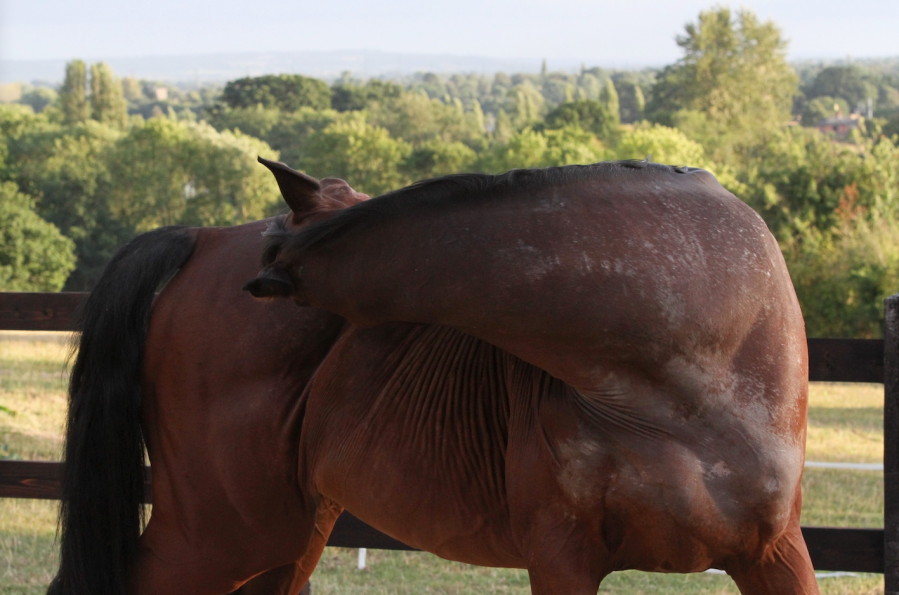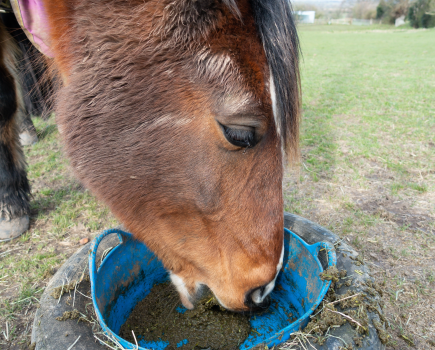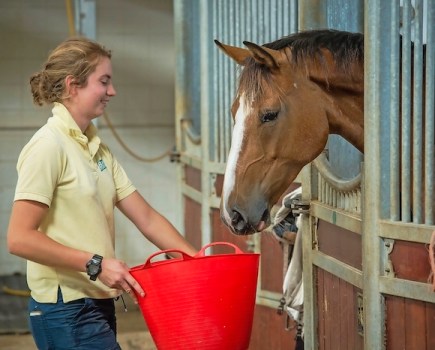Although itching generally begins in summer, equine vet Leona Bramall warns that sweet itch can be a year-round problem for some horses — and so as an owner or rider it pays to be aware of this itchy skin condition in all seasons.
Sweet itch in horses is caused by an allergic reaction to the saliva in the Culicoides midge when it bites. This triggers discomfort and itching, with some horses rubbing themselves raw. Sweet itch is a horse health condition that generally makes them feel very miserable.
The Culicoides midge loves warm, humid conditions with plenty of rain, which is why they tend to be more prominent (and more of a nuisance) in spring, summer and autumn.
Some horses and ponies become so itchy that they scratch areas of their bodies until they are red raw and bleeding, and this can lead to secondary infection. Manes and the top of tails are a particular problem areas for itching.
Managing sweet itch in horses
Prevention is better than cure when it comes to managing sweet itch and how you care for the affected horse is key.
“Horses develop itching of the mane and tail and, in some cases, the face and poll,” explains Leona.
“The level of severity varies. While some horses itch themselves bald, others may develop ulceration or secondary bacterial infections.”
Preventative measures include stabling at certain times, using fly rugs and masks, and being careful where you turn out. There is also an unofficial vaccine which has been found to help some horses suffering with sweet itch.
Sweet itch vaccine
Interestingly, a vaccine for ringworm, called Insol Dermatophyton, has been found to alleviate the symptoms of sweet in some horses.
It isn’t known how the vaccine works exactly, but it is being offered to more and more horses who suffer severe sweet itch symptoms.
It is usually administered ahead of midge season — so before a horse is showing any symptoms — and split into two vaccines 14 days apart.
Sweet itch in horses is a frustrating condition to manage. If you think your horse or pony may benefit from the vaccine, speak to your vet for advice. It may not be suitable for all horses and it is used off licence.
Early intervention is key
World Horse Welfare concurs that prevention is better than cure when it comes to managing sweet itch in horses. The charity reminds horse owners that the condition starts before the summer months begin.
“One of the worst things you can do is ignore the early signs. If you suspect your horse is suffering from sweet itch, the first step is to try to stop your horse from getting bitten and then contact your vet for advice,” says a charity spokesperson.
“Grooming your horse regularly is a good way to keep a close eye on their skin so you can recognise any changes and take appropriate action quickly.”
How to prevent sweet itch in horses
Preventing sweet itch in horses is all about reducing their exposure to the offending midges by doing the following:
- Stable affected horses at dawn and dusk, as this is when the midges are most active.
- Set up a fan (safely) in the stable, as this can help to deter midges from entering stables.
- Sweet itch fly masks and fly rugs play an integral role in protecting horses and ponies from biting midges and therefore can help to prevent sweet itch symptoms. They may need to be worn in the stable too.
- Fly and insect repellents can also be useful, although the effectiveness of these varies and they need to be topped up regularly. Apply fly spray to your horse’s rug too.
- Stronger insecticide sprays are available, which can be used periodically. Deosect is one example, which can be bought from your vet.
- When turning out, choose a field well away from marshy areas or adjacent to woodland, as these have high populations of midges. You should also avoid fields with stagnant water.
- Use an anti-itch shampoo and/or barrier cream targeted at horses with sweet itch.
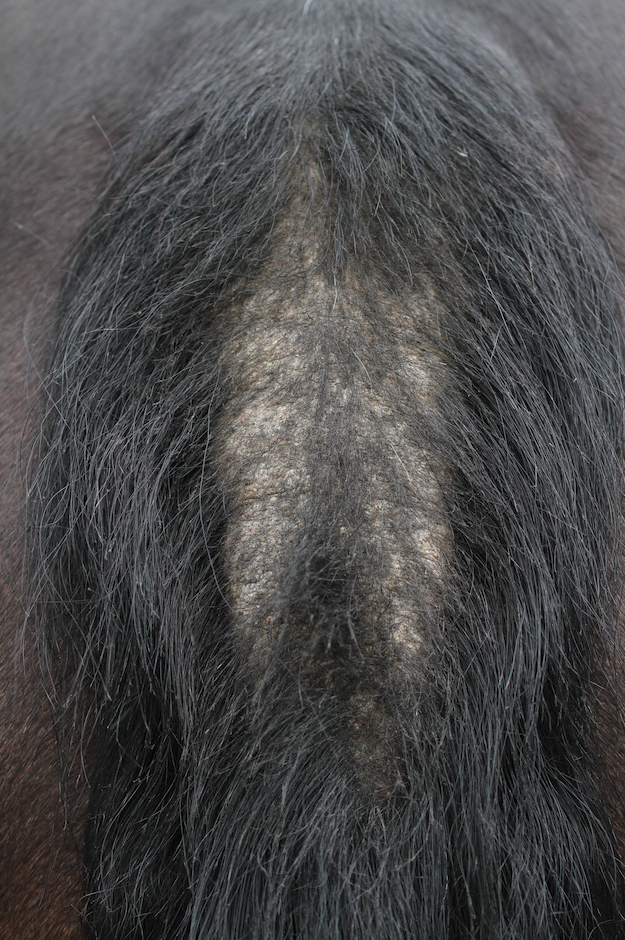
When to call a vet
“Contact your vet if your horse’s itching continues despite using the above preventative measures, if skin is hot and inflamed, or if you’re concerned about possible infection,” advises Leona.
“Your vet will examine your horse and may prescribe injectable, oral and/or topical (cream) medications.”
Leona also warns that in addition to sweet itch, some horses can develop skin lumps (urticaria), with or without associated itching secondary to other flies and insects.
Severity varies from a small lump at the site of contact to an extensive hypersensitive response.
“If your horse is stabled during the day, ensure their stable is kept as clean as possible and skipped out frequently to reduce the number of flies in the stable environment,” she adds.
“You can also spray the stable with fly repellents, but don’t spray directly near water or feed buckets. If the lumps on your horse are extensive, don’t appear to be resolving, or make your horse itch, seek advice from your vet.”
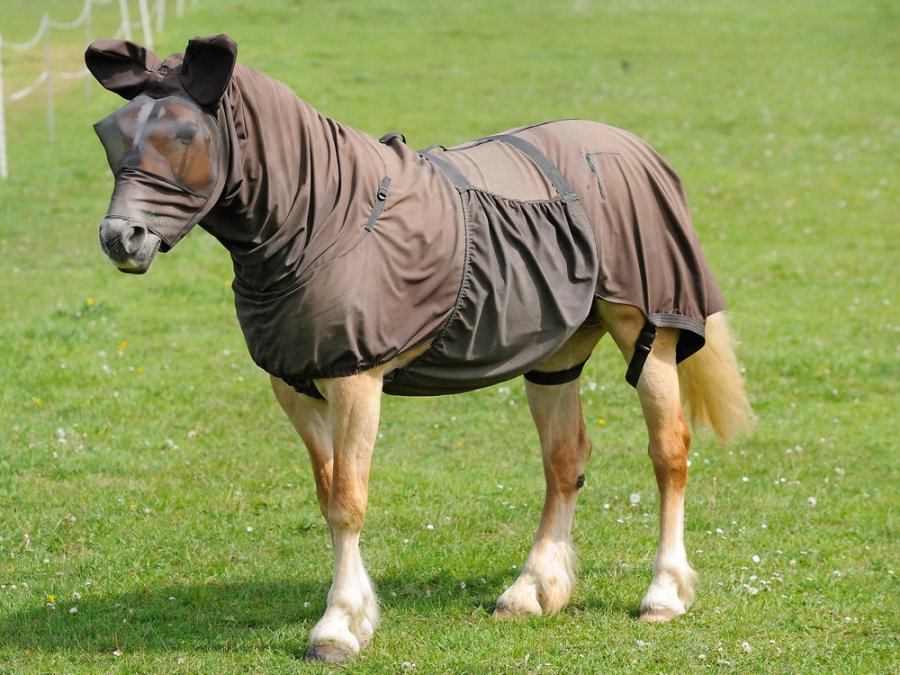
How herbs can help
According to Hilary Page Self, medical herbalist and director of Hilton Herbs, there is research and anecdotal evidence to show that herbs can be used to help minimise the symptoms of sweet itch in horses.
Useful herbs to consider include the following, but remember to consult your vet before making any sudden dietary changes:
Steamed linseed
Steamed linseed has been known to alter the fatty-acid profile of the horse’s hair and reduce irritation. Linseed is a rich source of the essential fatty acid, Alpha Linolenic Acid (ALA), and research suggests that foods rich in ALA could reduce inflammation and improve the clinical appearance of sweet itch.
Brewer’s yeast
Brewer’s yeast contains a range of B vitamins and amino acids that are said to help reduce the horse’s allergic response to the Culicoides midge. This yeast also makes the blood unpalatable to midges and is vital for hair growth and the production of cell membranes.
Buckwheat
Buckwheat contains high levels of flavonoids and anti-oxidants, such as quercetin, which acts like an anti-histamine and an anti-inflammatory.
Silica
Silica is a major component of hair so the rich silica content of diatomaceous earth is what helps stimulate hair growth, hair strength and hair quality.
“Sweet itch is a very difficult condition to treat,” says Hilary. “Most horse owners end up managing the problem with a combination of things such as a midge rug, organising turnout to avoid peak midge times and topical products and feed supplements.
“Always bear in mind that just because a substance is deemed ‘natural’, it doesn’t mean it can be used excessively,” continues Hilary.
Respect the instructions for use in the same way you would with conventional medication.
“Ensure that all herbal supplements and healthcare products are sourced from suppliers who can guarantee top-quality ingredients and expert formulations.
“These suppliers should be able to provide detailed information on product use and there’s a legal obligation on manufacturers to clearly state ingredients on the packaging.”
Is it sweet itch?
Excessive rubbing, bald patches or broken skin are all signs that a vet should be consulted.
Although sweet itch in horses is common, there are other reasons why a horse may become itchy which should be ruled out as a possible cause.
Lice
Lice, for example, are difficult to see with the naked eye. While some horses carry lice with few clinical signs, others are intensely itchy and become very distressed.
Lice are easily transferred by grooming equipment and rugs, so all of this should be treated if a case of lice is diagnosed.
Pinworm
Pinworm is an intestinal worm found near the rectum and can easily be confused with sweet itch in horses, because it triggers a horse to rub its tail in a bid to alleviate itching around the rectum.
Adult pinworms lay eggs around the horse’s anus and surrounding skin. It’s these eggs and the sticky ‘glue’ used to attach the eggs to the skin that causes itching.
Skin infection
Lastly, a skin infection could be the cause of itching rather than sweet itch, especially when a horse has a thick winter coat. A visit from your vet will quickly lead to a diagnosis.

